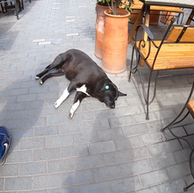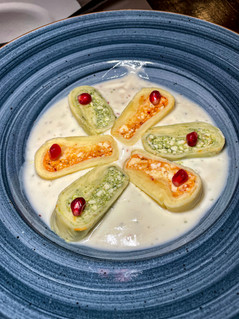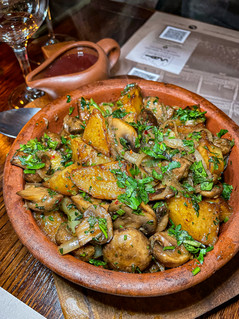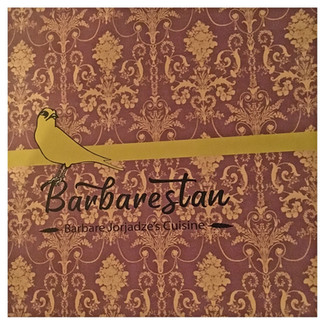GEORGIA, OH GEORGIA!
- Ally Landes

- Sep 30, 2019
- 18 min read
Updated: Jan 11, 2023
Known as Sakartvelo, “land of Kartvelians”, to Georgians, this wonderful little developing country is at the crossroads of Western Asia and Eastern Europe, bounded to the west by the Black Sea, to the north by Russia, to the south by Turkey and Armenia, and to the southeast by Azerbaijan. It currently has an estimated population of 4 million. It has a melting pot of history, having been ruled over by various regional powers such as the Mongols, the Ottoman Empire, Iran and the Russian Empire, and in retaliation, fought many wars. It was only liberated as the Republic of Georgia in 1995, when the constitution came into effect, to be known as, just that – Georgia!

TBILISI
We flew a very short 3-hour flight from Dubai to Tbilisi (population of 1.5 million) and based ourselves in a quaint little Airbnb off of Marjanishvili Street, which is a good 40-minute walk from the centre of Old Tbilisi where we spent most of our time. A lot of this city never sleeps and you will find many cafés/restaurants, pharmacies and supermarkets open 24/7. We pretty much had everything on our doorstep and were a 5-minute walk away from the very popular artsy Fabrika hostel, which was formerly a sewing factory. We had a bakery just next door which prepared fresh traditional Georgian sweet and savoury goods for our breakfast in the mornings. We never once used the metro stations as it is so easy to get around on foot, something we desperately needed given the utter lack of walking we do in Dubai. Let’s just say, we got to know Tbilisi in and out in a very short time, and truly loved it. September is a great time to go climate-wise, and it is not overcrowded with tourists.
Founded in the 5th century by King Vakhtang Gorgasali, Tbilisi is of course the capital, and the largest city in Georgia. It is an Orthodox Christian city with a Catholic church, Orthodox church, Synagogue, Minaret and Gregorian church all in one district. Suffice to say, there are a lot of churches, and there is some stunning and unique architecture to be seen around the city as well. It is made up of 10 districts, but only 3 or 4 main ones are wandered by visitors. Mtatsminda/Sololaki is the central district with small paved streets and old buildings seen with the traditional Tbilisi balconies. Rustaveli Avenue is the city’s main street and most popular with tourists, and leads you to Freedom Square which is the heart of the city.



First thing to do before anything else is to take one of the bus tours. You can catch one from Freedom Square. They only take 1.5 hours to complete the route. This may be the first or only bus tour you ever go on that serves home-made wine onboard! We promise that once you’ve done the bus tour, you will pretty much know your way around Tbilisi blindfolded and you will have come off a little wiser on its story.
FACT: The earliest evidence of wine to date was found in Georgia, where 8,000-year old jars were discovered in the Causcasus region.
Nearly everyone makes their own home-made wine, Chacha (clear pomace brandy – locals refer to it as their version of moonshine that ranges from 40% alcohol for commercial production and 70% alcohol for the home brew), and cognac. Our Airbnb hosts, Sopo and Alex left us with an excellent bottle of home-made cognac when we arrived, and chocolate to pair with it. This is true Georgian hospitality.
EXPLORING THE COUNTRY
We normally hire a car and do our own exploring when travelling, but on this occasion, we decided to book 3 days of tours after doing some online research. A car would have been a wasted expense for this week. Reading up on how much history there is, we figured we would be better informed if we were shown around, as there is so much to see and learn. Fortunately, the guides are all well-versed.
Unfortunately, we learnt we should have done the wine tour as our first tour, and not our last. We drank a lot of mediocre wines because of it (Georgian wine is quite unique), and there are some very good ones to be had if only we had known which ones to look for. This is highly recommended for anyone wanting to visit Georgia for the first time (and only if you’re into wine, obviously), not only to know which wines to drink, but out of interest on how Georgian wine making differs from the rest of the world.
This 12-hour wine tour took us through the Kakheti wine region on the eastern part of Georgia, home to some of the oldest human habitations in the entire Caucasus. The bus had its first rest stop at the roadside village of ‘Badiauri’ to taste the traditional freshly baked ‘shotis puri’ bread (we had the baked cheese one) which is pressed onto and cooked along the sides of this very large cylindrical beehive shaped clay oven called a ‘tone’. It’s 1 lari for the plain bread and 2 lari for the cheesy, highly recommended version. They were delicious just freshly baked.
We started the wine journey by visiting ‘Kakhetian Traditional Winemaking’ – one of the largest wine and spirit producing companies in Georgia – where you will taste wines unlike any other. It is an acquired taste (and smell) for some, but you definitely taste the difference from other worldly wines.
It’s not all about the wine, though. There are some interesting and pretty stops. There is the beautiful Georgian Orthodox ‘Bodbe Monastery’ with stunning views looking onto vinyards below. It was originally built in the 9th century and was significantly remodelled, especially in the 17th century. Today there is a brand-new church that takes precedence in the open garden by the view’s lookout point, built by a very wealthy Georgian tycoon.



There is a stop for lunch 2km along in Signagi, “the city of love”, which is known for the numerous weddings it hosts throughout the year.

There is one thing I will not miss about Georgia, and sadly, I have to say it’s the food – one thing apart from the wine they do take pride in. It really was a hit or miss experience. If you’ve ordered more than two things, you’re lucky to get it all and/or the wait can be… tediously long. This was especially common on the tours in the more rural areas and not the best Georgian you’ll taste, despite the fact that they are described as the best proper Georgian home cooked meals. Sauces are bland and meats are dried out. You’ll get to taste the popular Georgian dishes quite a few times and discover where the best examples can be found by the end of your trip. You’ll see what I mean later on.
The ‘Khareba Winery’ is located in Kvareli and it boasts a 7.7km long tunnel cellar where wines are preserved at a natural and ideal temperature of 12-14˚C. This is Georgia’s largest wine cellar. Visitors only visit a very small section of the tunnel but can see more than 25,000 bottles of premium wines aging in the alcoves. You are able to taste some of them as well as the locally produced grapeseed oil. This felt the most touristy of the three we visited, but all three are completely different from each other and all worth seeing.

Our last stop was to the ‘Kindzmarauli Corporation Wine’ which we really enjoyed. This is the most interesting of the three wineries. Not to mention, this is a full on sit down, generously poured wine tasting session by a professional sommelier of some of the best wines we had tasted all day. There is then a guided walking tour through the production steps of their wine facility, a visit to the wine laboratories where they monitor the quality control, and a look at where they produce the traditional Georgian Qvevri wine. Qvevri is the method of fermenting grapes in earthenware, egg-shaped vessels, which has been added to the UNESCO world heritage list.
FACT: Georgia has four recognised UNESCO World Heritage Sites – the Bragati Cathedral and Gelati Monastery both found in Kutaisi, the historical monuments of Mtskheta and Upper Svaneti.
UPLISTSIKHE, GORI, JVARI MONASTERY, AND MTSKHETA
This tour is only 9 hours long and the shortest of the 3 we did. Honestly, 12-hour and 9-hour tours just fly past with the full-on itinerary. The drive gives you a little break in-between. If you’re in it for the photography, well then you may feel a little rushed, but overall it seems well timed to make the most of it.
Uplistsikhe (Lord’s Fortress) is an abandoned cave town from the Bronze Age, 1,000 BC, which was inhabited until the 13th century AD. It played an important role in Georgian history as a significant political and religious centre between the 6th century BC and the 11th century AD before Christianity took centre stage. Once Christianity was introduced, the city lost its importance, but life continued, and they coexisted with both faiths for a short time. The cave town is divided into a lower, a central and an upper level, covering an area of almost 40,000 square metres. The very first thing you see when walking up is the Christian church at the very top of the area, and then you notice all the amazing caves carved into the rock. You really try to imagine what it could have been like in its heyday. The National Museum in Tbilisi houses a majority of the unearthed artefacts, but we never made it there.











Our next stop was to the Joseph Stalin Museum in Gori. It's well worth the visit. Who knew Stalin was originally Georgian and born right there in Gori? The highlights are his preserved wood-and-mud-brick house just outside the museum where he spent the first four years of his life (cannot be entered), and his “apparently” bulletproof train carriage in which he travelled to Yalta in 1945. You are able to go inside and walk through the carriage. We had an informed guided tour by one of the museum’s patrons and you’ve got some extra time to go back in and recap things you may have missed before moving on for the lunch at a local family’s home.

This was not a lunch to write about. They forgot to bring us our drinks, our potatoes to go with the 2 meat dishes, and the bread. The 2 meat dishes came about 20 mins after we placed the order, the rest we waited a further 30 mins before we had to ask where they were. This happened to a few others in the group. Poor food service can be quite common all over Georgia as we were told, and learnt from experience.
Our next stop was to the Mtskheta Church of Jvari (Holy Cross), the fourth UNESCO World Heritage Site I mention which was listed in 1994. This 6th century monastery sits atop a rocky mountaintop that overlooks the Mtkvari and Aragvi rivers and the old town of Mtskheta. The point of interest on this church and one that debates some uncertainty, is that of which nation can claim to have invented the “four-apsed church with four niches” form which is clearly seen at the top of this monastery’s entrance. It is thought that this is the earliest example to exist, but the exact date of the church’s construction is not known. This church had a great impact on the new developments of Georgian architecture and served as a model for many of the other churches.





Mtskheta was the capital of the Eastern Georgian Kingdom of Iberia from the third century BC, making it one of the oldest towns, and a cultural and religious centre of Georgia. Our last stop was to the Svetitskhoveli Cathedral, the third UNESCO World Heritage Site I listed. Svetitskhoveli, literally translates to the “Cathedral of the Living Pillar”. This is the masterpiece of the early middle ages and the second largest church building in Georgia, after the Holy Trinity Cathedral in Tbilisi. The structure was completed in 1029, but the site itself dates back to the early 4th century.







VARDZIA CAVE MONASTERY, RABATI CASTLE AND BORJOMI TOWN
This was most definitely our favourite 12-hour tour and we were luckily only four in our group so we ditched the minibus and were driven in the comforts of an unusually right-hand driven (they drive on the right-hand side in Georgia) 6-seater Honda Odyssey. The first stop was to the spectacular cave monastery of Vardzia in southern Georgia which is carved into the side of the Erusheti Mountain on the left bank of the Kura River. We could have spent a lot longer here with all the caves and tunnels there are to explore, and I could have done with a lot more time to get the footage I wanted here. It is surprisingly not yet on the UNESCO World Heritage List, but it has been submitted for future consideration. This is one we would come back to independently. The surrounding area is beautiful, and it seems there is a lot more to explore.






The version of the story told by our guide Nika is quite different from the articles I have read online (then again, I haven’t found any 2 exactly alike online either) when it comes to the history of Queen Tamar and how she was perceived by the people. Georgians all refer to her as King Tamar and they all talk about her with great admiration. Researching it online, King Giorgi III built a fortification here in the 12th century as a resistance against the onslaught of the Mongols and his daughter, Queen Tamar, ordered the build of the cave monastery in 1185 that grew into a holy city. It is said that 2,000 monks lived there. Nika says it only took 2 years to complete, but I have not found that fact anywhere as of yet, nor any that refers to Queen Tamar as King in the eyes of her subjects.
A century after its build and safe keeping the city from the Mongol hordes, mother nature took over and a devastating earthquake took the place apart in 1283, breaking the mountain slope and destroying more than two-thirds of the city, leaving it exposed.
It is very much still accessible, and in some tunnels, the old irrigation pipes still deliver fresh drinking water. In the eastern part of the site, there are 79 separate cave dwellings in 8 tiers, with a total of 242 rooms, including 6 chapels, a meeting room, a reception chamber, a pharmacy, and 25 wine cellars. In the western part, between the bell tower and the main church, there are 40 more homes in 13 tiers, with a total of 165 rooms, including 6 chapels, a refectory with a bakery and a forge. It doesn’t end there. Beyond the bell tower, it then rises to 19 tiers with steps leading to a cemetery.








The Church of the Dormition is of the most monumental significances by its paintings. Some were sadly lost during the 1283 earthquake, but what remains is very special to see. Vardzia has again become a working monastery since the end of the Soviet rule and a few monks live in caves that have been cordoned off for their privacy. They still ring the bells to this day.






You then walk down the valley and have lunch overlooking the Kura River and may still be able to catch a glimpse of Vardzia from below. The lunch was planned well in advance and we were made to order what we would want before going up to the cave city so that we wouldn’t have any delays afterwards. Well, we as the visitors were surprisingly well taken care of and it was the Georgians that sat waiting for 45 minutes to get their Mtsvadi which is very simply, skewered meat – while we had to go ahead and start while our food was still warm. Ordering in advance doesn’t necessarily make a difference… it is what it is!


Up next was a visit to the completely renovated Rabati Castle which was originally built in the 13th century as the Lomisa Castle. It was attacked in 1393 by the Turko-Mongol invasion, it survived, but was then completely rebuilt by the Ottomans in 1590 when they took over the entire area’s rule. The first mosque was built in 1752 right next to the Orthodox church, but the mosque is no longer used for religious purposes. The Russian Empire took it over in the 19th century. It was eventually brought to a semi-ruined state and in 2011 investments were made to rebuild and renovate the fortress in order to attract tourists back to the area. The surviving buildings date back to the 17th and 18th centuries, but there is more new than old to this tourist attraction. There is a restaurant, hotel, cafes and shops, as well as the mosque, church, castle and the museum.






The final stop of the tour is to Borjomi, which is known for its source of geothermal spring mineral water which is said to have unique healing qualities. The stench of sulphur is strong and the metallic taste, stronger. Worth giving it a try out of curiosity, but not one to quench a thirst.
We made sure to go up via the cable car in the park to get a good look at the sunset view before heading back to Tbilisi. You’ll spot a small waterfall on the right-hand side amongst all the greenery. Overall, it was a great day out, but Vardzia most definitely topped it all.
EXPLORING OLD TBILISI
One thing you will notice in the city are the drinking water fountains found everywhere. It is safe to drink from the tap and you can take your refillable water bottle with you to top up while you are out and about. Ground water visibly seeps from the ground and it has caused many of the older buildings to sink and break the foundations. It does seem quite alarming at how unsafe some of them look. We came across many derelict homes because of it, but unbelievably, some were still inhabited!
Legend has it that Tbilisi was named by King Vakhtang Gorgasali after he found his hunting falcon and its prey drowned in the hot sulfuric springs of the Abanotubani bath district. The word “Tbili” translates to “warm”. Sulphur baths were not something that inspired us to try, especially not when you read, ‘Sulphur baths relieve pain and itching caused by haemorrhoids’, but there are several bath houses here with a range of prices depending on the experience you’re looking for. Prices start from USD6, up to USD50 for a more private approach.
If you carry on walking right through to the end of this district, you will come to a dead end where you can see their mini Leghvtakhevi waterfall.

We walked across the river and up to the Holy Trinity Cathedral of Tbilisi, commonly known as Sameba (Trinity) which is the main cathedral of the Georgian Orthodox Church. It was constructed between 1995 and 2004 and is the third-tallest Eastern Orthodox cathedral, and one of the largest religious buildings, in the world. As far as architecture goes, it is an impressive building to view in person and is in the same neighbourhood as the new Presidential Administration palace.





The one thing we did not get to experience in its full glory was the Dry Bridge (Mshrali Khidi) flea market. The bridge was being renovated while we were there, so it did not emphasise the hustle and bustle to be expected. Vendors had moved on down into the park along the roadside pavement, and they really do sell anything that can be salvaged.


We took the cable car from Rikhe Park up to the 4th century Narikala Castle. The fortress has the skyline view across all of Tbilisi and the Mtkvari River, and you can clearly see all the main landmarks. Earthquakes have caused much havoc in Georgia and in 1827, one damaged and demolished much of this fortress, but this is the best panoramic view there is.


THE LOCAL DOGS
If you are a dog lover, you will be in heaven with all the sweet street dogs, if not a little crushed on wanting to give them all a home. Street dogs are everywhere in Georgia. The ones we have come across have all been very friendly, seeking cuddles. They all look well fed as they are fed by the public who love and respect them. You do need to look where you step as they like to sleep smack in the middle of pavements and walking paths. They are all neutered by the government in order to control their numbers, and all sport an ear tag as proof. We made a lot of doggo friends in the city!
GEORGIAN CUISINE
My love-hate relationship with Georgian food has been profound. I love that locals take pride in their traditional foods, but I get frustrated when it doesn’t match up to the expectations as I know some of it should be fantastic. “Eat where the locals eat”, but they ate everywhere we went, so it wasn’t a successful system. Researching places to eat makes it to the top of my list when planning trips, but reading reviews can be a waste of time as tastes vary greatly, but also, a moment in time varies from one day to the next. The thing about Georgian cuisine is, it's not varied at all. Everywhere serves exactly the same thing on their menus. It can be very, very good; or very, very bad!
If you are used to Dubai prices when you eat out like we are, you will eat like kings in Georgia for a third of the price at the more fine dining establishments. That includes the wine. We had our first experience with Georgian food in Almaty of all places, in Kazakhstan last year, and it was such a delicious experience that we had looked forward to trying more of it on its own home turf. Quality though, proving hard to find.
We had a list ready of local dishes to try, such as the Khinkali dumplings, the Khachapuri cheese bread (the boat-shaped version with butter and egg yolk on top from Adjara was the most accented), the Mtsvadi skewered meats (if you like your meats cooked rare or medium, you’ll have to tell them as they like their meats very well done, to the point they are dried out), the Chaqapuli stew (you must like tarragon as it makes up the base of this veal broth), and assorted Pkhali cold appetisers (aubergine, beetroot or spinach, ALL flavoured with walnut paste).
The Chicken Shqmeruli is the most favourite Georgian dish everyone tells you to order (garlic and cream chicken), but we just couldn’t see what the hype was about until we ate it at the Old City Wall Restaurant and Salobie Bia. We tried it at several restaurants before we tasted these versions – you can’t say we didn’t give it a chance. The previous ones we had, were either very bland runny milk sauces with very dry chicken pieces, or prepared with mayonnaise and extra garlic – the latter we had been warned we might experience is not at all authentic and nauseating.
Khinkali is a broth dumpling eaten by hand with a sprinkle of black pepper (the end you hold is not eaten) which is stuffed with beef or pork, cheese, mushroom or potato which are found everywhere. The first ones we had at the Shilda Winery didn’t assert any cravings to try more (the dough was too thick and chewy). I also tried a soup version that is exactly the same thing, except the dumplings are just in more broth and more difficult to eat. I don't recommend it, it doesn't make them any tastier. There are however some excellent Khinkali out there, you just need to know where to go to get them.
The Khachapuri Adjara is a bread boat filled with cheese, butter and an egg yolk you mix all together, and then hack off the ends and dip in for more oozing richness. The regular Khachapuris are cheesy flat breads. Our favourite is the Khachapuri Skewer straight out of the oven which is the bread rolled into a sausage and filled with hot oozing cheese.

If you get confused seeing the shop stalls selling what looks like candlesticks or waxy sausages, you’re looking at Churchkhela, the traditional Georgian sweets. They are threaded walnuts, almonds or hazelnuts, or dried fruits which have been repeatedly dipped into a mixture of concentrated grape juice, sugar, and flour, building up layers of thick, waxy fruit syrup which dries to form a jelly-like coating. They come in a colourful variety of different flavours. They are ready after about five days of air drying and have quite a long shelf life. They are different and worth a try. We loved the honey ones.

RECOMMENDATIONS OF WHERE TO EAT IN TBILISI
The Old City Wall Restaurant and Wine Bar: This is hands down, our favourite restaurant in Tbilisi. This was what we expected traditional home-cooked Georgian food to taste like.
The Chicken Shqmeruli here is a healthy golden custard of flavourful garlic-milk sauce with succulent chicken pieces and a perfectly crispy chicken skin, beautifully garnished with watercress, baked apple slices and pomegranate. Everything we had at the Old City Wall Restaurant was fantastic. We went back three times to make sure, and the standards hold.
Not only is the food good here, they also have traditional Georgian music sung to you by a group of gentlemen enjoying their own food and drinks from their own table amongst the guests. They sing in-between a drink or a bite, and lend a glorious ambiance to your dining experience. They start at 8pm in the evenings, so make sure to go there for dinner.
Salobie Bia: Another restaurant we recommend is Salobie Bia for good simple Georgian food. The menu is small, but we ate well.
They make a fantastic Lobiani here which is the flat bread stuffed with beans. Eat it while it's fresh out of the oven. The Lobio (bean stew) contains coriander, walnuts, garlic and onion and was served with pickled cabbages, and kimchi (had no idea Georgians made kimchi, but there is no comparison with Korean kimchi), and was served with Mchadi (Georgian corn bread rather on the dry side). An interesting dish combo to try once.
We loved their Chicken Shkmeruli. One of the best we’ve had along with that of the Old City Wall restaurant's. The chicken was so tender and the sauce was the perfect consistency and level of garlic. The polenta and beef stew (cannot find the Georgian name for this dish) was excellent. Highly recommended to go ahead and order this one!
Pasanauri on Leonidze Street: According to a reliable Georgian source, this is where you will get the best Khinkali. We tried 2 variety of beef ones as recommended, and a mushroom one. We can confirm these were the best ones we've had.
Not all Pasanauri restaurants are of the same level on food, and it depends what you order, and who makes it. We came back to try their Khachapuri Adjara for a late breakfast another day which was mediocre, and served a very dry and hard to chew chicken skewer, and the worst Lobiani which I had ordered with ham to change, but it came without. It's a hit or miss. Stick to the Khinkali here.
Barbarestan: They have seasonal menus and although this looks like a dressy restaurant, you can walk in as casual as you like. We had a good meal and pleasant fine dining experience which was needed after eating a lot of the same dishes everywhere else.
Café Littera: The venue is lovely, and the food was an uplifting experience which we highly recommend. This restaurant is only open in the summer as the seating is outside in the garden. It is advised to book a table in advance.
THE TOURS WE RECOMMEND
Uplistsikhe Tour: www.getyourguide.co.uk/tbilisi-l1379/tbilisi-mtskheta-jvari-gori-and-uplistsikhe-day-tour-t213894/
Vardzia Tour: www.getyourguide.co.uk/tbilisi-l1379/from-tbilisi-full-day-tour-of-vardzia-rabati-and-borjomi-t214350/
























































































































Comments